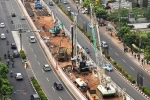Three railway projects offered to investors
This article has been translated by PwC Indonesia as part of our Indonesia Infrastructure News Service. PwC Indonesia has not checked the accuracy of, and accepts no responsibility for the content.
Investor Daily - Tiga proyek kereta api ditawarkan ke investor
By Heru Febrianto
Jakarta, ID – The Transportation Ministry through the Railways Directorate General is offering various railway projects in Indonesia to foreign investors for cooperation.
Railways Director General of the Transportation Ministry Risal Wasal said that the railway infrastructure projects offered included the Bandung urban railway development. Besides that, the Railways Directorate General is also offering the airport train and the urban railway in Nusantara Capital City (IKN) to investors as potential projects for cooperation.
These projects were offered by Risal to the attendants of the 2024 Shanghai International Exhibition for Intercity and Urban Mass Transit held on 5-7 June 2024 in Shanghai, China.
During his session titled Foreseeing Indonesia: A Rail-based Emerging Power, Risal mentioned that the three projects were part of the strategic plan of the Railways Directorate General for 2024-2029.
“To realise the targets in the strategic plan, we are providing an opportunity for you to participate in the development of the railway sector in Indonesia, which includes the three projects with high economic potential,” Risal said in his press statement, quoted on Wednesday (12/6/2024).
The Bandung urban railway was selected as one of the projects offered due to its strategic role in accommodating high public mobility and connecting the Whoosh high-speed railway to the economic centres in the metropolitan area. The Bandung urban railway project is forecasted to have an investment return rate of 11.9%, supported by a viability gap fund of 49%.
“Given this significant potential, we are providing an opportunity for you to participate in the Bandung urban railway project through the public-private partnership (PPP) scheme, with a concession period of up to 30 years,” Risal said.
Furthermore, regarding the development of railway transportation in IKN, Risal mentioned two planned projects were open for investment. The two projects are the Sepinggan Airport-IKN railway and the IKN urban railway that will serve citizens in the new area.
The Sepinggan Airport-IKN railway is projected to serve 5.2 million passengers annually by 2030, reducing travel time to 30 minutes for the 46.04-kilometer route. This railway will also pass through economic centers in East Kalimantan, acting as a catalyst for growth in the area.
“Meanwhile, the IKN urban railway is expected to connect the new capital city to its surrounding cities, such as Balikpapan, facilitating public mobility between the two cities,” Risal continued.
To support the development plan of the IKN urban railway, Risal mentioned that the government was ready to provide support in the form of land procurement and a viability gap fund of 49% from the total investment value.
At the 2024 Shanghai International Exhibition for Intercity and Urban Mass Transit, the Railways Directorate General also invited stakeholders and industry players to offer their products and services.
The business entities represented by the Railways Directorate General at the event included PT Adhi Karya Tbk, PT Wijaya Karya Beton Tbk, PT Kereta Cepat Indonesia China, PT Kereta Commuter Indonesia, PT Celebes Railway Indonesia, and PT Len Railway Systems.
Besides the event, the Railways Director General and the delegates from Indonesia also visited the Shanghai Engineering Research Centre of Driverless Train Control of Urban Guided Transport on 4 June 2024 and Tongji University on 6 June 2024.
“This is an excellent opportunity for us to learn and develop the railway sector in Indonesia to be a rail-based emerging power,” Risal added.
Operating by 2029
Previously, Nusantara Capital City Authority (OIKN) revealed that the airport train connecting the central government core area (KIPP) to Sepinggan Airport in Balikpapan was expected to operate in 2029.
“The feasibility study is currently underway by the Transportation Ministry,” OIKN Funding and Investment Deputy Agung Wicaksono said, quoted by Antara recently.
The Sepinggan Airport-IKN railway is planned to operate in 2029.
“Yes, in the next five years, we hope the IKN-Balikpapan airport railway will operate,” Agung said.
The Sepinggan Airport-IKN railway is meant to be a transit-based macro transportation mode connecting IKN to Balikapan, facilitating intercity accessibility.
The airport train is expected to reduce travel time from IKN’s KIPP to Sepinggan Airport in Balikpapan to 34 minutes for a distance of 46.06 km. Passenger numbers are projected to reach 1.3 million annually by 2030.
The estimated investment value for the airport train project is US$3.2 billion, including US$121 million for the trainsets.
The Sepinggan Airport-IKN railway is expected to be constructed in 2027-2028. The airport train is planned to be operated by PT KAI.
Low share of freight trains
Indonesia Transportation Society (MTI) Regional Empowerment and Development Deputy Chairperson Djoko Setijowarno stated that a study conducted by the Transportation Ministry in 2022 found that railways were not seen as an attractive option for supporting logistics transportation.
“The share of freight trains is still less than 1%. Rail-based transportation is advantageous for distances between 750 km to 1,500 km compared to other modes. However, the utilisation rate of the double-track railway on the Pantura and Pansela routes is still below 60%. The intermodal connectivity of railways with other modes of transportation remains very limited,” Djoko said to Investor Daily.
He explained that the transportation infrastructure built in Indonesia was not balanced. There is disparity between the eastern and western regions. “Despite efforts to address the disparity, it is still an issue. There are still numerous challenges to realise the Golden Indonesia 2045 vision in the transportation sector,” he added.
Djoko explained that, according to a study by the National Development Planning Agency (Bappenas) in 2019, the backbone connectivity between islands was still suboptimal. Return cargo from eastern Indonesia is still insufficient, with an average load of 100% resulting in only 30% return cargo from the east.
“The lack of load factor is attributed to the limited economic centers in eastern Indonesia. Additionally, there is a lack of optimal loop and pioneer services. Ferries, air transportation, and land transportation have not been integrated optimally yet,” he added.


















